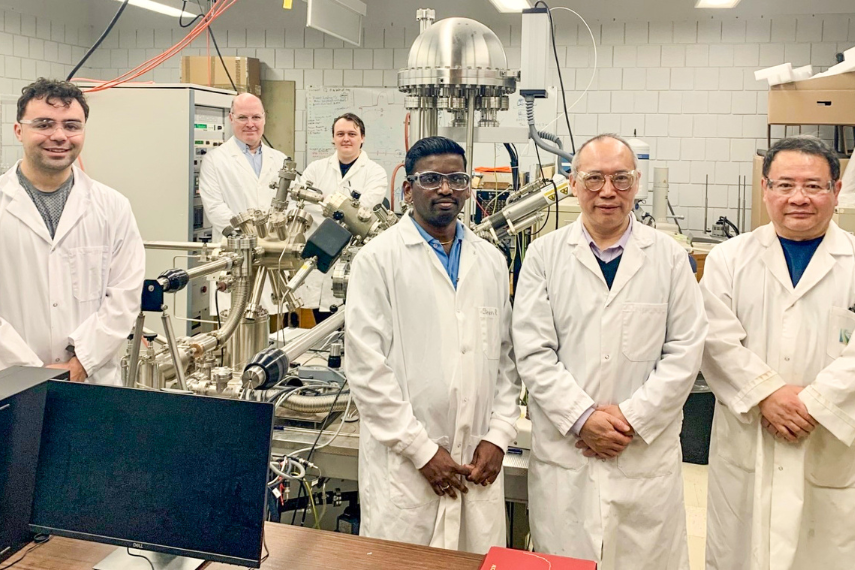Splitting Water Molecules for Clean Hydrogen Production

Our level of dependence on energy from fossil fuels is unsustainable, which drives the need for renewable and clean energy sources. A solution might come from hydrogen, the most abundant element in the universe.
Hydrogen is an energy carrier with the potential to be employed as a fuel source in various renewable energy processes. While abundant, hydrogen does not typically exist naturally on its own. It needs to be released from hydrogen containing compounds such as water, comprised of hydrogen and oxygen (H2O) to be used.
Dr. Aicheng Chen, Professor in the Department of Chemistry at the University of Guelph and Tier 1 Canada Research Chair in Electrochemistry and Nanoscience, is studying how hydrogen can be released from water. In a process called “water splitting,” an electric current is passed through water, which separates and releases the hydrogen and oxygen atoms. Water is a sustainable resource that produces clean hydrogen, without the production of any troublesome byproducts.
While this may appear to be the clean energy solution that we have been looking for, there is a catch: water splitting requires a catalyst (a substance that accelerates a reaction) to make the process efficient enough for practical use. Platinum has been used as the standard catalyst in the past, but the high cost limits its practical use.
Finding an Alternative Catalyst
Researchers in the Departments of Chemistry and Physics at the University of Guelph teamed up with Chen to produce an alternative catalyst to platinum. They needed their catalyst to be low cost, durable, and still efficiently produce clean hydrogen.
“Ruthenium, a metal similar to platinum, is being explored as an alternative catalyst,” explains Chen. “Ruthenium is less than half the price of platinum.”
Chen and the research team investigated how ruthenium nanoparticles could be fabricated and used as a catalyst to produce hydrogen from water. They developed a method of producing tiny particles of ruthenium (a few nanometers in diameter) using a simple one-step process. The ruthenium nanoparticles were found to be highly stable and outperformed platinum in terms of their ability to catalyze hydrogen production from water.
With expertise from Dr. Stefan Kycia and Dr. De-Tong Jiang from the Department of Physics, a combination of chemical and physical characterization techniques were used, including state-of-the-art X-ray scattering measurements completed at the Brockhouse X-Ray Scattering Sector and spectroscopic studies at the HXMA beamline at the Canadian Light Source (CLS) synchrotron in Saskatoon, to understand the structures and physicochemical properties of the ruthenium nanoparticles.
Setting a New Standard
The fabrication of high-performance ruthenium nanoparticles by Chen and his collaborators has the potential to make a significant impact on clean energy alternatives.
“We have developed a facile fabrication process that can be easily scaled up,” says Chen. “The nanoparticles exhibit high stability and activity, even better than the benchmark standard.”
The ruthenium nanoparticles and methods used to fabricate them offer a lower cost alternative to hydrogen generation compared with conventional catalysts. With improved stability and performance, they are also more practical for real-world applications. This work has strong potential to set a new standard for hydrogen production for sustainable energy solutions.
This story was written by Carley Miki as part of the Science Communicators: Research @ CEPS initiative. Miki is a PhD candidate in the Department of Physics under Dr. John Dutcher. Her research focus is on understanding the forces and interactions between soft, sugar-based nanoparticles and how they are altered when charged.
This work is supported by the National Sciences and Engineering Research Council (NSERC) of Canada. Synchrotron XRD and XAS characterization was conducted at the Canadian Light Source. The authors acknowledge Ning Chen, Beatriz Moreno, Graham King, and Aly Rahemtulla, as well as the support of the CLS science and operations staff.
Hung, C. K., et. al. Tailoring Hydrogen Evolution Performance: Size and Phase Engineering of Ruthenium Nanoparticles. ACS Catal. 2024, 14, 5416-5428. doi: https://doi.org/10.1021/acscatal.4c00368

Physics

Chemistry

Physics